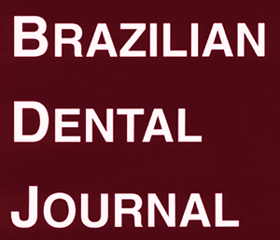Resumo
Este estudo observacional transversal com 24 participantes teve como objetivo avaliar as diferenças na força de mordida (FM) e na PM (performance mastigatória) entre usuários de prótese total convencional (PTC) e de overdenture mandibular (OM) e a correlação entre essas variáveis. O teste de FM foi realizado bilateralmente com um dispositivo de força oclusal. Durante o teste de PM, os pacientes foram solicitados a mastigar uma porção padronizada de Optocal por 40 ciclos mastigatórios. O teste de Shapiro Wilk foi empregado para verificar a normalidade dos dados, o teste T de Student para identificar diferenças entre os grupos e os coeficientes de correlação de Pearson para investigar inter-relações entre variáveis. Uma regressão linear múltipla foi realizada pelo método stepwise. Valores de p≤0,05 foram considerados estatisticamente significantes. Diferentemente dos usuários de OM, os usuários de PTC apresentaram uma diferença significativa (34%) na FM entre o lado dominante e o não dominante (p=0,04). Os usuários de OM apresentaram FM significativamente maior (p=0,01) sem apresentar um lado dominante (p=0,38) e obtiveram PM significativamente melhor nos seguintes parâmetros: os valores de PMX50 diminuíram 27,25% (p=0,01), PMB diminuiu em 48,38% (p=0,01), e EM 5.6 diminuiu 53,25% (p=0,02), enquanto EM2.8 aumentou 151,57% (p=0,01). A FM e PMX50 no grupo de usuários da IMO foram negativamente correlacionados (-0,57;p=0,05); esse coeficiente de correlação foi o único parâmetro incluído no modelo de regressão multivariada. Os usuários da OM possuem maior FM e melhor performance mastigatória do que os usuários de PTC, observados principalmente na redução do tamanho das partículas mastigadas. A PM está correlacionada com um maior FM nos usuários da OM através de uma melhor trituração de partículas.

 Evaluation of Bite Force and Masticatory Performance: Complete Denture vs Mandibular Overdenture Users
Evaluation of Bite Force and Masticatory Performance: Complete Denture vs Mandibular Overdenture Users